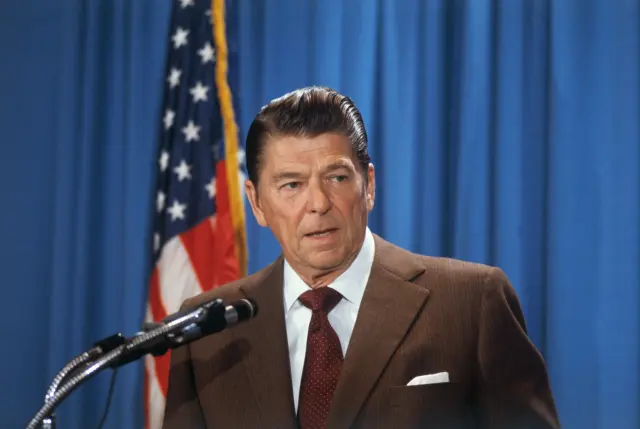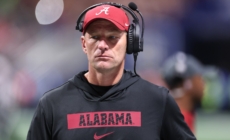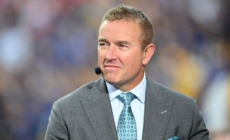-
Zac Gallen Predicted To Sign $135M Deal With NL Club Despite Cubs Rumors - 10 mins ago
-
How Has Congestion Pricing Changed Your Year? - 32 mins ago
-
Ancient African city rises from ashes of colonialism - 45 mins ago
-
Fire in Goa, India, Kills at Least 25 - about 1 hour ago
-
Warriors HC Steve Kerr Rips Into Two Players With Team Struggling - about 1 hour ago
-
Alabama’s Kalen DeBoer Makes Clear Case for CFP After Loss to Georgia - 2 hours ago
-
How Australia’s Social Media Ban for Children Will Work - 2 hours ago
-
BYU Publicly Calls Out Kirk Herbstreit Over CFP Statement - 2 hours ago
-
Social worker stabbed in attack at San Francisco General Hospital dies - 3 hours ago
-
Everyone Wants High-Quality Clothes. That’s Become Its Own Trend. - 3 hours ago
List of Tariffs Ronald Reagan Implemented as Trump Cancels Canada Talks
President Donald Trump’s tariff policies have been compared with those of former President Ronald Reagan, after Trump announced on Thursday that he was ending trade negotiations with Canada.
Trump curtailed talks after accusing an Ontario TV advert of misquoting Reagan’s tariff stances.
The clip showed Reagan talking about the downsides of tariffs, including job losses and trade wars, but the Ronald Reagan Presidential Foundation said the clips were selective in nature and not representative of Reagan’s full speech.
“Based on their egregious behavior, ALL TRADE NEGOTIATIONS WITH CANADA ARE HEREBY TERMINATED,” Trump wrote.
Why It Matters
Trump’s trade policies have centered around ‘reciprocal’ tariffs on an array of other countries. The president pushed forward a 35 percent tariff on many imports from Canada, although goods under the United States-Mexico-Canada Agreement have largely been excluded.

What To Know
While the audio clip of Reagan during a radio address on tariffs and free trade from April 25, 1987, in Camp David in Maryland appears to indicate Reagan was anti-tariffs, the full address reveals a more nuanced picture of Reagan’s viewpoints on the matter.
“The words of President Reagan are being used to highlight how he used tariffs and viewed them differently than the current administration in certain situations. While he did use tariffs as a negotiation tool in certain trade discussions, such as with Japan, he saw them as a long-term problem for further trade talks and for the American worker who would more than likely have to pay them,” Alex Beene, a financial literacy instructor for the University of Tennessee at Martin, told Newsweek.
Reagan’s administration implemented many targeted tariffs and import restrictions despite his public pro-free trade persona.
From 1981 to 1985, Japan agreed to voluntary export limits on automobiles, capping them at 1.68 million cars a year.
In terms of actual tariffs, a 45 percent charge was applied to heavyweight motorcycles in the 1980s as well, and foreign steel was capped at 18.5 percent of the U.S. market.
“Reagan’s biggest impact came in the auto sector. He imposed tariffs and import limits to protect American automakers, largely under pressure from Congress and domestic industry groups. The current administration has taken a far more unilateral approach using executive orders instead of congressional backing and has extended tariffs broadly across multiple nations and industry,” Kevin Thompson, the CEO of 9i Capital Group and the host of the 9innings podcast, told Newsweek.
“The result has been a trade war hitting American farmers and manufacturers the hardest. In the end, we as taxpayers often foot the bill through farm subsidies and aid packages meant to offset those losses.”
Reagan also implemented a 100 percent tariff on $300 million of Japanese electronics in 1987.
His policies extended to agriculture and textiles as well.
From 1982 onward, the administration reinstated import quotas on sugar to support domestic prices. There was also a 25 to 40 percent tariff enforced on EEC pasta and 200 percent tariffs on EEC food products related to Spain and Portugal grain disputes.
More largely, Reagan pushed negotiations and frameworks that eventually led to the North American Free Trade Agreement.
Trump has criticized NAFTA as the worst trade deal ever and instead signed the United States—Mexico—Canada Agreement (USMCA) into effect. This modernized NAFTA in many ways and required 75 percent of auto content to be made in North America.
“Reagan understood tariffs are like antibiotics. They might fight an infection, but misuse them and you end up sicker,” Michael Ryan, a finance expert and the founder of MichaelRyanMoney.com, told Newsweek. “His 1980s strategy wasn’t protectionism, it was triage. He reluctantly imposed selective duties on Japanese cars and sugar only to defuse Congress’s push for far harsher restrictions. As Reagan himself warned, ‘Protectionism is destructionism.’”
What People Are Saying
Ryan told Newsweek: “He (Reagan) viewed free trade as the path to strength, not surrender. Trump’s approach flips that logic. Where Reagan sought leverage to pry open markets, Trump wields tariffs like blunt instruments to close them. Reagan’s tariffs were temporary, and strategic. Trump’s have become structural, bordering on economic identity.”
Drew Powers, the founder of Illinois-based Powers Financial Group, told Newsweek: “Reagan’s trade policy came to be described as ‘free but fair,’ which was an oxymoronic way to reconcile his campaign trail promises of free trade and his administration’s practice of protectionism. Trump’s trade policy is far more heavy-handed—it seems more a way of dominating the competition and sometimes perceived to be a negotiation in bad faith.”
“The bottom line is that tariffs hurt a consumer’s bottom line. Foreign governments did not pay Reagan’s tariffs and they do not pay Trump’s tariffs, U.S. consumers do.”
Thompson told Newsweek: “Reagan was a strong supporter of free trade and open markets, but he wasn’t afraid to use tariffs strategically to reduce trade deficits. His approach was targeted similar in spirit to today’s focus on advanced chips and technology.”
What Happens Next
Even during Reagan’s time, consumers paid a price, as they likely will continue to do so under Trump’s tariffs, Ryan said.
“The auto restrictions alone cost Americans an estimated $2 billion a year in higher prices, and ironically strengthened Japanese competitors by pushing them to build in the U.S.” Ryan said. “Reagan took the heat, but he kept his eye on a freer market. Trump takes the spotlight and widens the divide.”
Source link




















